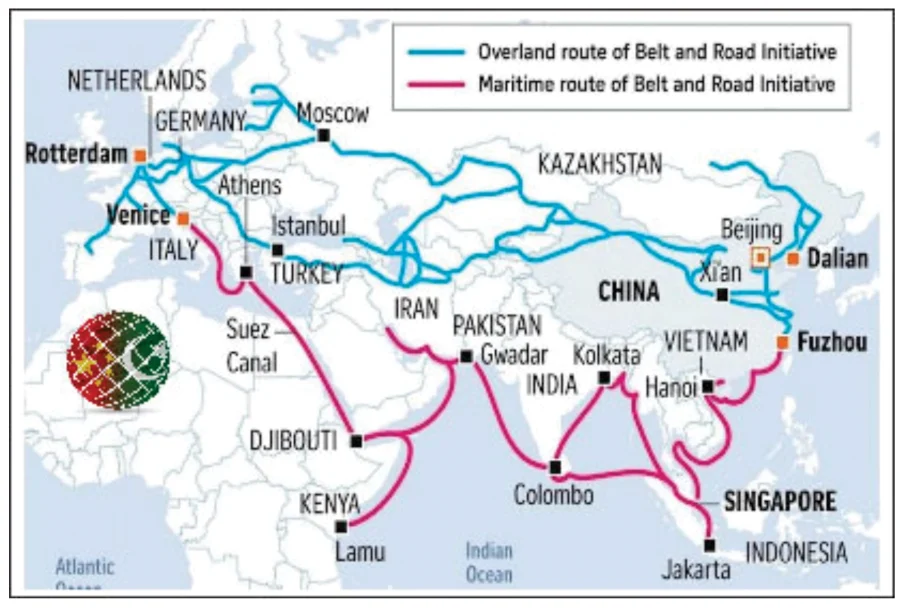No country can exist in isolation from the rest of the world. The population growth has multiplied demands, urging the countries to ensure feasible road infrastructure for imports and exports to meet their day-to-today needs.
Nature has endowed each region with different resources: from minerals to seashores, mountainous terrain to fertile lands, deserts to forests, and more. While sharing the same planet in the global village, no nation wanted to be left behind in the race for economic prosperity and infrastructural development. Therefore, it became necessary to conceive a project that could connect people through formal routes beyond their geographical boundaries, ensuring the long-lasting sustainability of the human race.
Instead of exploitation and plunder to invade the smaller communities, developing and underdeveloped countries, it was thought to have long-term agreements with them for letting them benefit from their existing potential of rich natural resources while also playing the role of the bridge. Thus the Chinese core philosophy ‘to create a win-win situation for everyone’, especially for the member countries has emerged a strong binding force to forge this connection through Belt and Road Initiatives (BRI) extended worldwide from Asia to Africa and Europe by the Chinese government – the mega project creates road linkages. The connections made through BRI had its roots in the historic ‘Silk Road’ – the ancient trade route used for centuries.
Primarily, the BRI, also known as “a project of the century” has proposed to build a land-based “Silk Road Economic Belt,” extending from China to Central and South Asia, the Middle East and Europe and a sea-based “21st Century Maritime Silk Road,” connecting China to Southeast Asia, the Middle East, Africa and Europe via major sea lanes. This forms the Belt and Road Initiative (BRI), officially known as “One Belt, One Road”. It is actually a vast array of roads, railways, power plants, ports, smart cities, telecommunications and information technology and e-commerce platforms around the world. It promotes people-to-people ties, financial integration and closer trade relationships with a range of other countries.
Essentially, the project of One Belt and One Road (OBOR) was launched in 2013 as a viable strategy to bring the underdeveloped countries as par with the developed parts of the globe. The project was lauded worldwide for working on enhancing mutual ties based on infrastructural development, trade, business avenue creation, education, automobile, construction materials, railways, roads, highways, airports, ports, power grids, energy and so many other economic opportunities.
The BRI project has attracted a major portion of the globe, with the number of its signatory member countries increasing to more than 150, along with 30 international organizations. These countries cover more than half of the world’s GDP and 75 percent of the total population. Spearheaded by the Xi Jinping Administration, this project aims to bolster the concept of a shared future for mankind, emphasizing harmony and diversity through a three-pronged agenda of regional connectivity, economic prosperity and infrastructural development. The project has proven instrumental in boosting global GDP by creating shared prosperity for a bright future among all member countries.
The overwhelming response from the partner countries has made the BRI as one of the largest investment and infrastructure projects in recent human history. It is due to the fact that the project is focusing on public good and socio-economic development of the developing countries. According to the document, “Vision and Actions for High-Quality Belt and Road Cooperation: Brighter Prospects for the Next Decade” formulated by the Office of the Leading Group for Promoting the Belt and Road Initiative (BRI), the gains made by the project during the last decade (2013-2023) has been found tremendous while a roadmap was also made for the coming decade. The new projects under the BRI are now focusing on building new industries as growth engine, novel business models, and emerging technologies.
The BRI brings about large-scale and high quality development to the regions – abridging the economic divide between the developed, developing and under-developed countries. The new impetus of BRI is not only re-invigorating the existing economic strength of the partner countries but it is also becoming a crucial platform for the overall global development. The project is ushering a new era in world history by re-vitalizing global trade and economy while ensuring the United Nations 2030 agenda of sustainable development. The success of BRI is grounded in worldwide attention and public recognition of the project as it focuses on the wellbeing of the people.
The BRI is actually reshaping economic development on a larger global scale – creating new avenues for connectivity and infrastructural development across regional and national geographical boundaries. Such a broad spectrum of developmental opportunities opens up new doors for local, regional and international development. The establishment of new routes and trade connections among the partner countries would help facilitate the process of development through export-oriented manufacturing, which brings about positive and visible impact in the region.
The BRI creates the possibility to enhance industrial production and their transportation through supporting expertise and infrastructure – allowing the partner countries to play their dynamic role in the development of the overall global economy. This establishment of the Initiatives also enables the environment to build special economic zones (SEZs) for hosting new factories to make products for export markets. The initiative that installs new trade routes and more efficient transportation networks reorients global commerce. It has also the potential to increase economic growth of the underdeveloped regions of all the partner countries.
views expressed are writer’s own.










